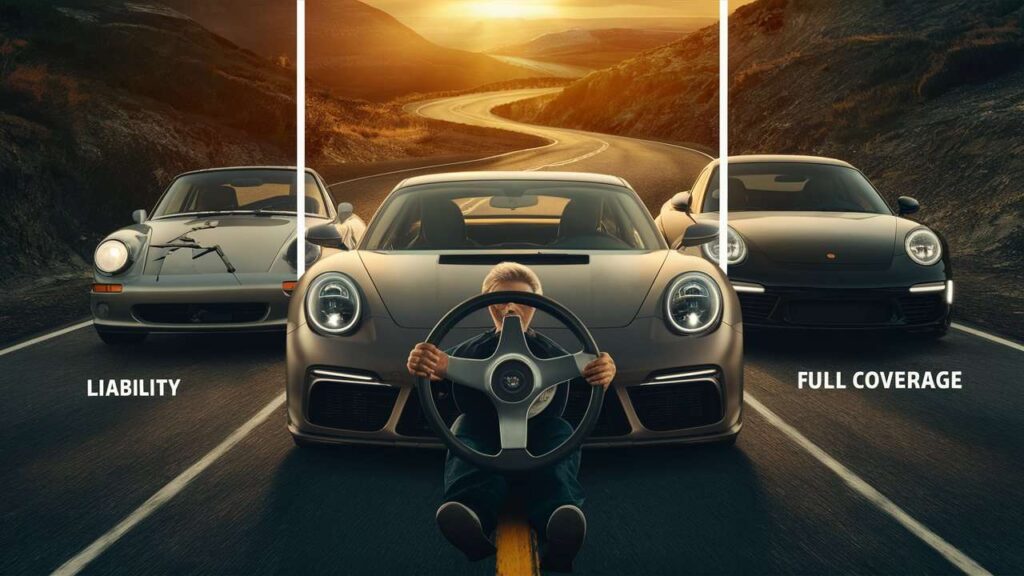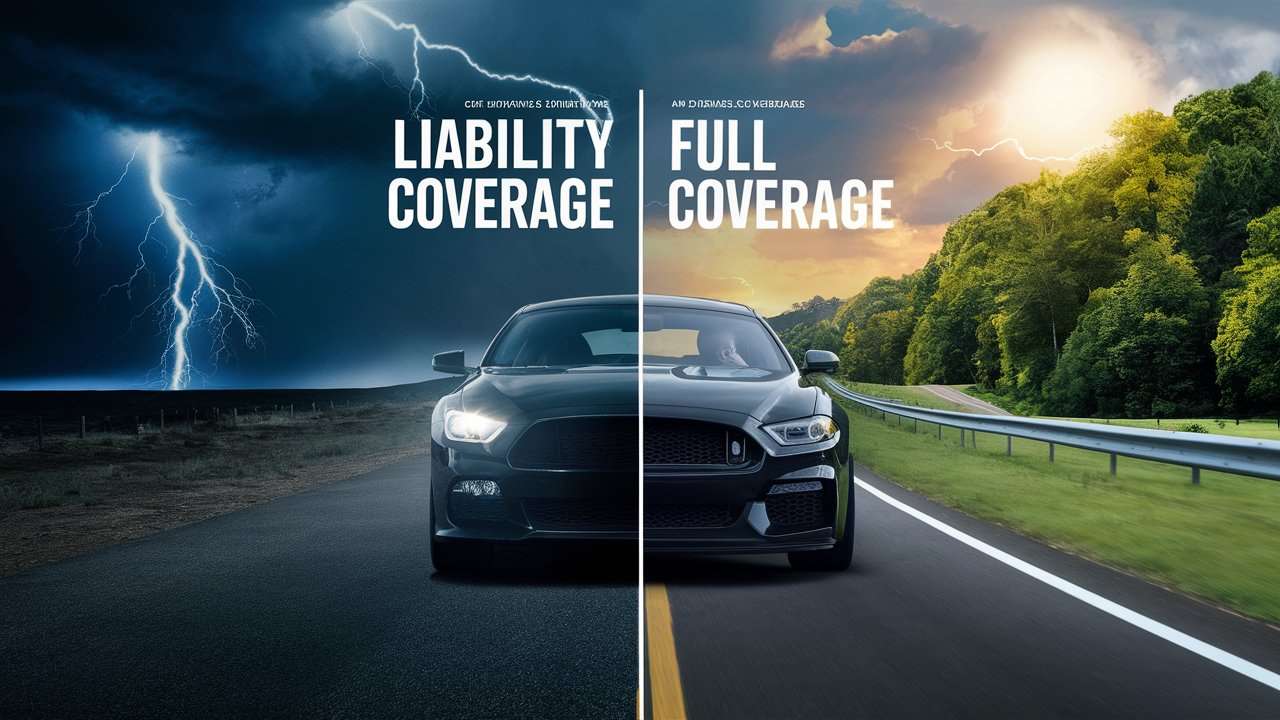Introduction
What’s the Big Deal About Car Insurance?
Car insurance isn’t exactly the stuff of daydreams, but it’s as essential as a spare tire. Think of it as your financial bodyguard, ready to jump in when you need it most. Whether you’re dodging the dings of daily driving or navigating the high seas of potential accidents, car insurance keeps you from sinking into financial trouble. In a nutshell, it’s the unsung hero of vehicle ownership, making sure you don’t end up paying for every fender-bender out of pocket.

Why You Need to Know Your Coverage Options
Understanding your coverage options is like knowing the difference between a first aid kit and a full-blown emergency room. Sure, a bandage might suffice for a small cut, but when it comes to car insurance, you want to make sure you’re equipped for the whole range of possible mishaps. Dive into the nitty-gritty of Liability versus full coverage, and you’ll find yourself better prepared for whatever road-related surprises come your way.
Liability Car Insurance
What is Liability Coverage? The Basics
Liability coverage is the car insurance equivalent of a basic toolkit. It’s designed to handle the essentials: if you’re at fault in an accident, this coverage pays for the damage you cause to others. It’s like admitting, “Oops, my bad!” and letting someone else pick up the tab. Think of it as your financial apology🤑gracious, but not exactly comprehensive.
Boring but Important: What Liability Covers
Liability insurance covers two main things: bodily injury and property damage. Bodily injury coverage takes care of medical expenses for those injured in an accident you caused. Property damage, on the other hand, handles repairs to vehicles or property you’ve wrecked. It’s the responsible adult’s choice, ensuring you’re not left high and dry when things go sideways.

The Pros of Liability Insurance (Spoiler: It’s Not All Bad)
Sure, Liability insurance might seem like the less glamorous sibling of full coverage, but it has its perks. For starters, it’s usually more affordable. Less money spent on insurance means more money for those spontaneous weekend road trips🤑or just paying off your latte addiction. Plus, it’s often a legal requirement, so it’s a win-win: you stay compliant and keep more cash in your pocket.
The Cons of Liability Insurance (Yes, There Are Some)
But don’t let the lower premiums fool you🤑Liability insurance has its limitations. It doesn’t cover your own vehicle’s damage or your medical bills if you’re hurt. Imagine walking away from an accident with a pristine car but a hefty hospital bill. Liability insurance might leave you feeling like a financial piñata, with everyone taking a swing at your savings.
Full Coverage Car Insurance
What’s in a Full Coverage Policy?
Full coverage is like the deluxe version of car insurance. It typically includes both Liability coverage and additional perks like collision and comprehensive insurance. Collision coverage pays for repairs to your car after an accident, no matter who’s at fault. Comprehensive coverage, meanwhile, handles the unexpected🤑think theft, vandalism, or even that rogue deer who decided to play chicken with your fender.
All the Details: What Full Coverage Covers
With full coverage, you’re not just getting more insurance; you’re getting peace of mind. In addition to collision and comprehensive coverage, you might also get extras like roadside assistance and rental car coverage. It’s like having a Swiss Army knife for car insurance🤑whatever happens, you’re prepared.

The Upsides of Going Full Coverage
The perks of full coverage are pretty stellar. You’re shielded from a wider array of potential mishaps, meaning fewer surprises and less out-of-pocket expense. If your car gets damaged by something wild, like an asteroid or a particularly aggressive squirrel, full coverage has your back. Plus, it can boost the resale value of your car, as you’re less likely to end up with a totaled mess.
The Downsides of Full Coverage (Yes, It’s Not Perfect)
Of course, full coverage isn’t without its flaws. The main downside is the cost. It’s like the premium edition of a subscription service🤑you get more, but you also pay more. If you’re driving an older car that’s not worth much, the extra expense might not be justifiable. Additionally, full coverage can sometimes lead to complacency; with so much protection, you might not be as cautious as you should be.
Comparing Liability and Full Coverage
The Battle of the Policies: Liability vs Full Coverage
Choosing between liability and full coverage is like picking between a reliable sedan and a flashy sports car. Liability is straightforward and budget-friendly, while full coverage offers a comprehensive safety net. It’s a matter of assessing your needs and deciding whether you want to play it safe with a basic policy or go all in with a top-tier option.
Cost Comparison: What Will You Really Pay?
When it comes to costs, liability insurance typically wins the budget-friendly award. It’s the cheaper option, but it comes with fewer bells and whistles. Full coverage, on the other hand, demands a heftier price tag. However, if you’re driving a new or high-value vehicle, the extra cost might be worth it for the added protection.
Coverage Comparison: What’s Included and What’s Not
Liability coverage gives you the basics, while full coverage offers an all-inclusive package. Liability is like a standard buffet🤑simple but satisfying. Full coverage is the extravagant feast with all the trimmings. Assess what’s included in each to decide which better suits your needs and appetite for protection.

Real-Life Scenarios
When Liability Insurance Could Save the Day
Imagine you’re in a minor fender-bender. Your Liability insurance kicks in to cover the other driver’s repairs and medical costs. It’s the safety net that ensures you don’t have to dip into your savings to cover someone else’s damages. In this scenario, liability insurance is your unsung hero, keeping your finances intact while you sort out the aftermath.
When Full Coverage is the Real MVP
Now, picture this: a hailstorm turns your car into a Swiss cheese-like mess. Full coverage swoops in to cover the damage, saving you from a hefty repair bill. It’s the insurance equivalent of having a superhero on speed dial🤑ready to leap into action and save the day. For those who want comprehensive protection, full coverage is the way to go.

Making the Smart Choice
How to Choose Based on Your Driving Habits
Your driving habits play a significant role in determining the best insurance for you. If you’re a cautious driver who avoids high-risk scenarios, Liability coverage might suffice. But if you’re frequently on the road or navigate treacherous weather conditions, full coverage could be the wiser choice. It’s all about matching your insurance to your driving lifestyle.
Choosing Based on Your Budget: Saving vs Splurging
Budget considerations are crucial. Liability insurance is easier on the wallet, but it offers limited protection. Full coverage costs more but provides a safety net against a broader range of issues. Weigh the cost against the protection you need to make a decision that aligns with your financial situation and comfort level.
What Your Car’s Age and Value Have to Do With It
The age and value of your car can influence your choice. For a brand-new or high-value vehicle, full coverage is often a smart move to protect your investment. For older or less valuable cars, liability insurance might be sufficient. Consider your car’s worth and how much you’re willing to spend on insurance versus potential repairs.
Common Misconceptions
Myth-Busting: Liability Insurance Isn’t Just for Bad Drivers
There’s a misconception that liability insurance is only for reckless drivers. In reality, it’s a standard option that ensures you’re covered if you’re at fault in an accident. It’s not about being a bad driver🤑it’s about being a responsible one who prepares for the unexpected.
Full Coverage Isn’t Just for Fancy Cars
Another myth is that full coverage is reserved for luxury vehicles. While it’s often recommended for new or high-value cars, it’s not exclusive to them. Full coverage provides peace of mind regardless of your vehicle’s make or model. It’s about ensuring you’re protected, not just about flaunting a fancy ride.

Tips for Finding the Best Coverage
How to Shop for the Best Deal (Without Losing Your Mind)
Shopping for insurance doesn’t have to be a mental marathon. Start by comparing quotes from different providers and evaluating their coverage options. Look for discounts that might apply to you, such as safe driver or multi-policy discounts. It’s about finding the best bang for your buck without getting lost in the weeds.
Questions to Ask Your Insurance Agent
When speaking with an insurance agent, don’t hold back. Ask about coverage limits, deductibles, and any potential exclusions. Clarify what’s covered under collision and comprehensive policies, and inquire about additional perks like roadside assistance. An informed decision is a smart decision.
Conclusion
Wrapping Up: The Smartest Choice for Your Ride
Choosing the right car insurance is like finding the perfect pair of shoes🤑comfort and functionality are key. Whether you opt for liability or full coverage, ensure it fits your needs and lifestyle. Make a choice that keeps you safe on the road and your wallet intact.
Making the Final Decision: A Quick Recap
In the end, it’s about balancing cost with coverage. Liability insurance is budget-friendly and covers the basics, while full coverage offers a comprehensive safety net at a higher cost. Assess your driving habits, budget, and vehicle value to make a well-informed decision. Drive smart and stay protected!

People Also Ask
What is the cheapest full coverage car insurance?
The cheapest full coverage car insurance often varies by location, personal driving history, and vehicle type. However, companies like GEICO, State Farm, and Progressive are frequently recognized for offering competitive rates for full coverage policies. It’s wise to get quotes from multiple providers to find the most affordable option tailored to your specific needs.
Is full coverage the same as comprehensive?
No, full coverage is not the same as comprehensive insurance. Full coverage typically includes both Liability and comprehensive insurance, along with collision coverage. Comprehensive insurance covers damage to your car from non-collision events like theft, vandalism, and natural disasters, while full coverage encompasses a broader range of protections.
What full coverage doesn’t cover?
Full coverage doesn’t cover everything. It usually excludes damage caused by deliberate actions, wear and tear, mechanical failures, or damages not related to accidents or natural events. It also typically doesn’t cover injuries to yourself or your passengers; for that, you’d need additional coverage like personal injury protection (PIP) or medical payments coverage.
How do you tell if you have full coverage?
To determine if you have full coverage, check your insurance policy details. Full coverage generally includes liability, collision, and comprehensive insurance. Review your declarations page or contact your insurance agent to confirm that your policy covers these aspects.
What is the most basic car insurance coverage?
The most basic car insurance coverage is Liability insurance. It covers damages you cause to others in an accident, including property damage and bodily injury. This type of coverage is often the minimum required by law.
Which brand of car has the cheapest insurance?
Insurance costs can vary widely based on the car model, but generally, brands like Honda, Toyota, and Subaru tend to have lower insurance rates. These brands are often associated with safety and reliability, which can help reduce premiums.
What is the lowest level of car insurance?
The lowest level of car insurance is typically Liability insurance. It provides coverage for damage or injury you cause to others in an accident but doesn’t cover your own vehicle’s damages or injuries.
What is the cheapest category for car insurance?
The cheapest category for car insurance usually falls under Liability coverage, as it offers the minimal protection required by law. It’s often the most affordable option but comes with limited coverage.
How much is full coverage insurance in Florida?
The cost of full coverage insurance in Florida varies based on factors like your driving record and vehicle type, but on average, it can range from $1,500 to $2,500 per year. For the most accurate rate, getting quotes from several providers is recommended.
How much is full coverage insurance in Texas?
In Texas, full coverage insurance generally costs between $1,200 and $2,000 annually, depending on factors such as your driving history, location, and the vehicle you drive. To find the best rate, compare quotes from multiple insurance companies.
Is it better to have a $500 deductible or $1000?
Choosing between a $500 and $1,000 deductible depends on your financial situation and risk tolerance. A lower deductible means higher premiums but less out-of-pocket expense when filing a claim. A higher deductible lowers your premiums but increases your upfront cost if you need to make a claim. Consider your budget and likelihood of needing to file a claim when making this decision.
What is the meaning of full coverage?
Full coverage refers to an insurance policy that includes liability, collision, and comprehensive coverage. It provides a broad range of protections for your vehicle, covering not just damages you cause to others but also damages to your own car from accidents and non-collision events.
What does fully comprehensive cover include?
Fully comprehensive coverage includes protection against damages to your vehicle from non-collision events such as theft, vandalism, natural disasters, and falling objects. It also generally includes collision coverage, which covers damages from accidents, and Liability coverage, which covers damages you cause to others.
What is a premium in insurance?
A premium is the amount you pay for your insurance policy, typically on a monthly or annual basis. It’s the cost of maintaining your coverage and is determined based on various factors, including your risk profile and the type of coverage you choose.
Is comprehensive the best type of insurance?
Comprehensive insurance is not necessarily the “best” type of insurance; it’s one component of a full coverage policy. It provides valuable protection against non-collision damages, but the best type of insurance depends on your individual needs, such as your driving habits, vehicle value, and budget. Full coverage, which includes comprehensive insurance, might be the most comprehensive protection for many drivers.









